Georgia, the southeastern state of the United States, is not only famous for its delicious peaches and historical landmarks but also for its unique state animals. These official animals, ranging from mammals to reptiles, hold a special place in Georgia’s culture and heritage.

Each animal represents the state’s rich history, natural beauty, and diverse wildlife. Join us as we explore the fascinating state animals of Georgia and learn about their significance to the state’s identity.
What is an Official Animal?
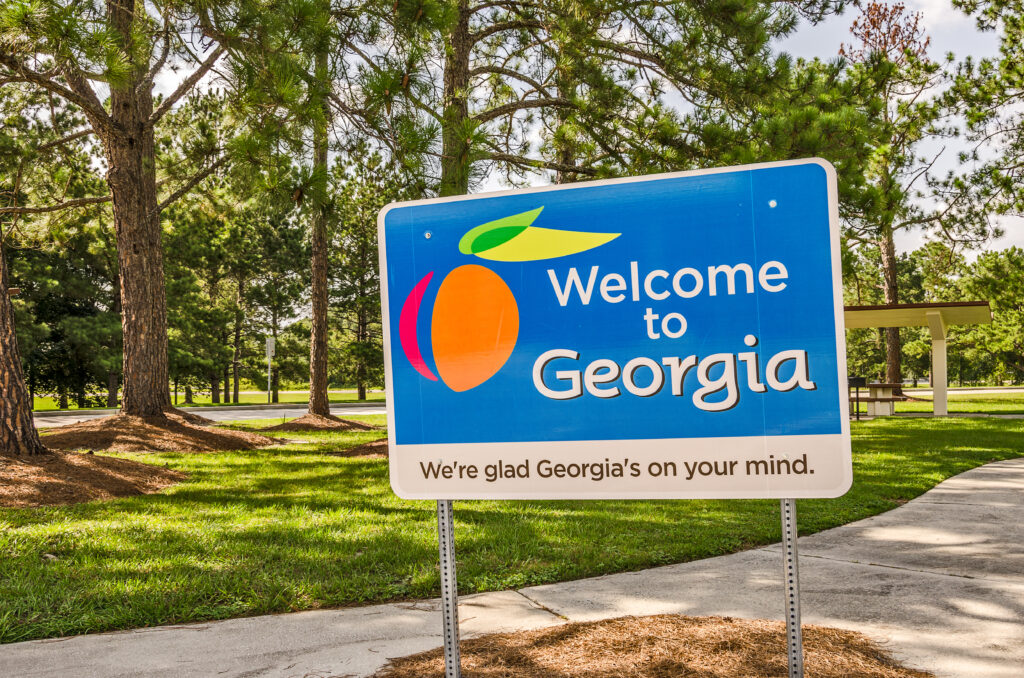
Georgia has several official animals, and each carries significance to the state.
©Sue Smith/Shutterstock.com
An official animal is a designation given to a particular species by a government or other organization to represent a specific geographic area, such as a state or country. These animals are often chosen for their symbolic, economic, or cultural significance.
But more than that, in some cases, designating an animal as an official animal can promote conservation efforts and increase public awareness of protecting a particular species. Official animals are sometimes designated based on historical or mythological associations.
Due to all of these reasons, official animals can vary from country to country and state to state. Exploring the official animals of a particular region can help us learn more about the country or state it represents.
Official State Animals of Georgia
Let’s get into the details of Georgia’s fascinating official state animals. Georgia currently has 13 state animals.
1. Amphibian – Green Tree Frog (Hyla cinerea)

The American Green Tree Frog is the official state amphibian of Georgia.
©LorraineHudgins/Shutterstock.com
Typically 1¼ to 2½ inches long, green tree frogs can be found in bright green, greenish gray, or yellow-green shades. The frog’s color may change depending on its activity level or temperature. For instance, the frog may appear yellow while making its call, and its color may appear duller or grayish during rest or cooler temperatures.
They are particularly known for their loud distinctive mating call and abrupt nasal bark or honk that can be repeated up to 75 times per minute. American green tree frogs are also popular pets because of their relatively easy-to-care-for nature.
This frog became Georgia’s official state amphibian in 2005, thanks to a group of fourth-grade students at Armuchee Elementary School who noticed the state lacked an official amphibian during their government and science studies in 2002. Out of the 85 species of amphibians found in the state, the students chose the green tree frog as their top pick, and their initiative eventually led to the law passing in 2005.
2. Bird – Brown Thrasher (Toxostoma rufum)

Georgia named the brown thrasher its state bird in 1935.
©iStock.com/johnandersonphoto
The brown thrasher features gray-brown faces and dark streaking on their white underparts. Their bright yellow eyes complement their two black-and-white wing bars. This songbird is sizable and boasts a lengthy, slightly downcurved bill. It also showcases sturdy, elongated legs and a tail often cocked upward, similar to wrens. They can grow up to 12 inches in length.
The brown thrasher is a skilled singer capable of producing over 1,100 different songs, some of which include imitations of other birds such as wood thrushes, northern flickers, and chuck-will’s-widows. They are also known for being aggressive defenders of their nests, as they can attack people and other animals hard enough to draw blood.
The reason behind Georgia’s selection of the brown thrasher as its state bird remains unclear. However, the bird’s distinctive song is believed to have influenced the decision. In 1935, Georgia’s governor declared the brown thrasher the state bird, and the state legislature later officially recognized it in 1970.
3. Butterfly – Eastern Tiger Swallowtail (Papilio glaucus)
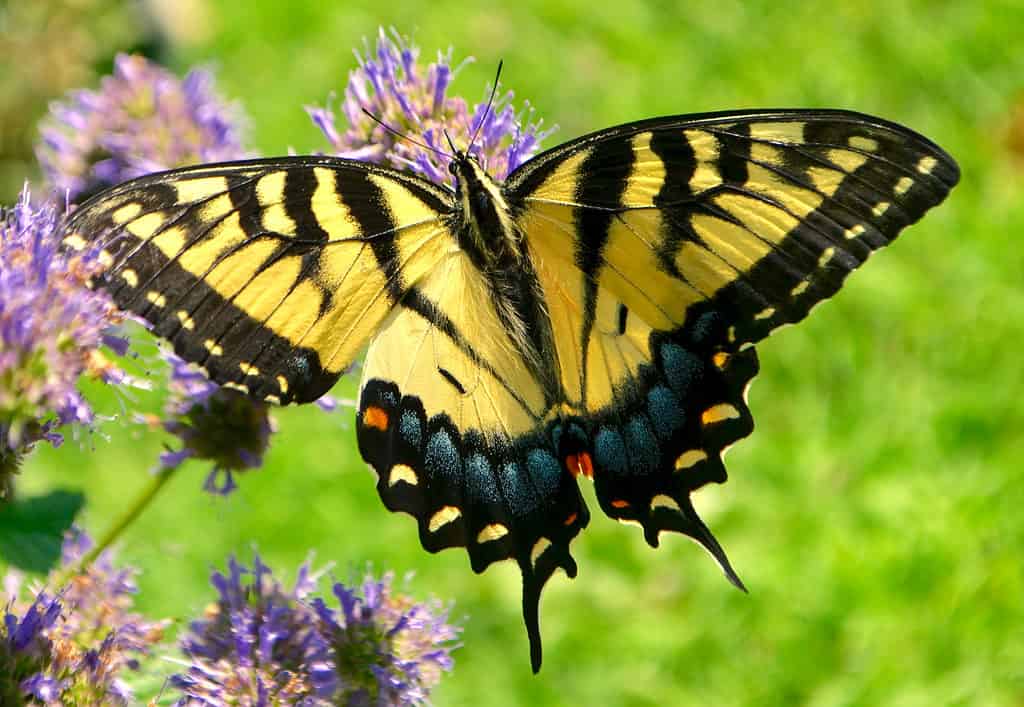
The glorious Eastern
tiger
swallowtail butterfly is one of the official Georgia state symbols.
©Maria T Hoffman/Shutterstock.com
The wingspan of adult Eastern tiger swallowtails can range from a diminutive 3 inches to an impressive 5 and a half inches. Their wings are marked by four black parallel stripes at the top and a solid black stripe along the base. Interestingly, the females tend to have more blue on their hindwings than the males.
Like most butterfly species, eastern tiger swallowtails tend to be solitary creatures. The males, in particular, actively search for mates by patrolling different areas. They can detect areas of high moisture absorption by the sodium ion concentration in the region.
The eastern tiger swallowtail is not only beautiful but also ecologically important. It is a crucial pollinator for many economically significant plants in Georgia. Due to its value, Georgia’s state butterfly was officially designated as the eastern tiger swallowtail in 1988. You can spot them fluttering about from spring through fall.
4. Cold Water Game Fish – Southern Appalachian Brook Trout (Salvelinus fontinalis)
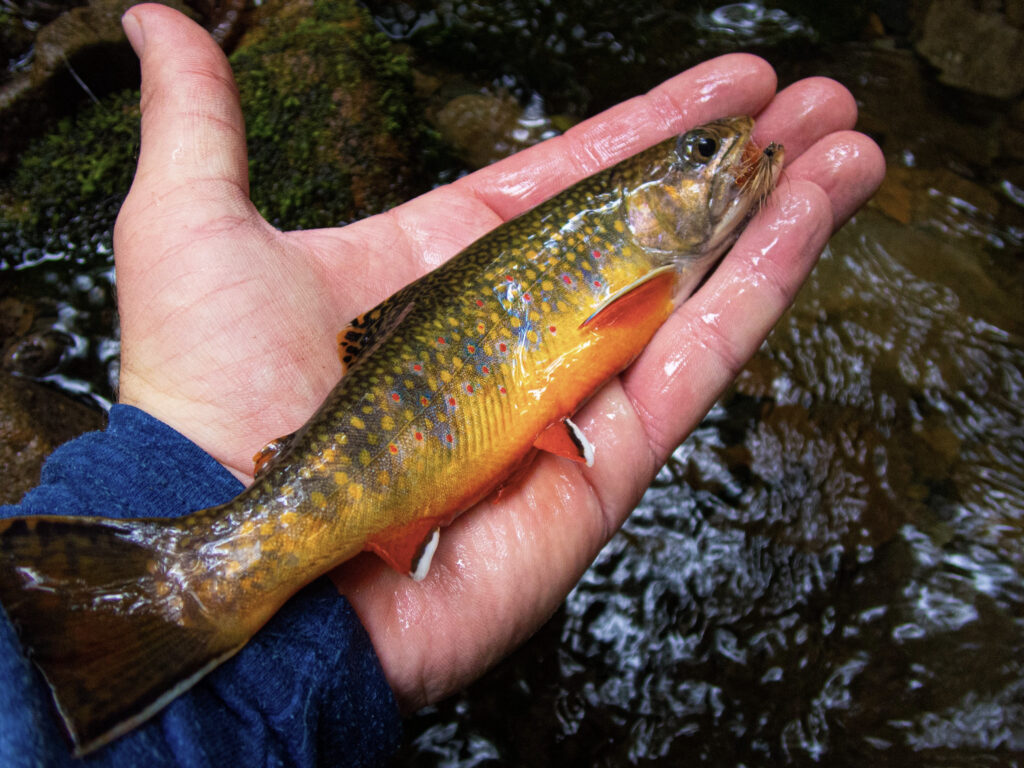
Georgia has a flourishing trout population, including the Southern Appalachian brook trout.
©iStock.com/Devin Davenport
Brook trout are distinguishable by their olive-green upper sides marked with dark green speckles along their tails and backs. The fish’s lighter lower sides display a plethora of yellow spots, with infrequent spots of vivid red encircled by blue. Typically, these striking fish reach a length of about 6 to 8 inches.
Georgia’s brook trout populations flourish in high-altitude headwater streams that are secluded and unpolluted, with abundant oxygen levels. These streams require gravel free of silt for successful spawning, consistent water flows, and ample riffles and pools containing in-stream cover such as logs to support the thriving of brook trout.
In recognition of its native presence in high-elevation streams of the southeastern region of the United States, including Georgia, the Southern Appalachian brook trout was designated as the official state cold water game fish of Georgia in 1995. This designation highlights the importance of protecting these fish and their habitat, preserving their natural beauty, and ensuring their survival for future generations.
5. Dog – Adoptable Dog

Georgia has its “adoptable dog” as its official state dog.
©hedgehog94/Shutterstock.com
The Georgia General Assembly defines “adoptable dog” as any canine available for adoption by the general public and under the care of a humane society, private or public animal refuge, or an animal shelter.
In 2016, Georgia lawmakers passed a bill designating the “adoptable dog” as the official state dog. This move shows the state’s affection for needy animals and recognizes the tireless efforts of animal shelters and their staff throughout the state.
Georgia’s official state dog status for the adoptable dog raises awareness about the importance of animal welfare and shelters’ vital role in the community. It serves as a reminder to all citizens that adopting a dog is a valuable and rewarding experience that benefits both the adopter and the adopted pet.
6. Fish – Largemouth Bass (Micropterus salmoides)
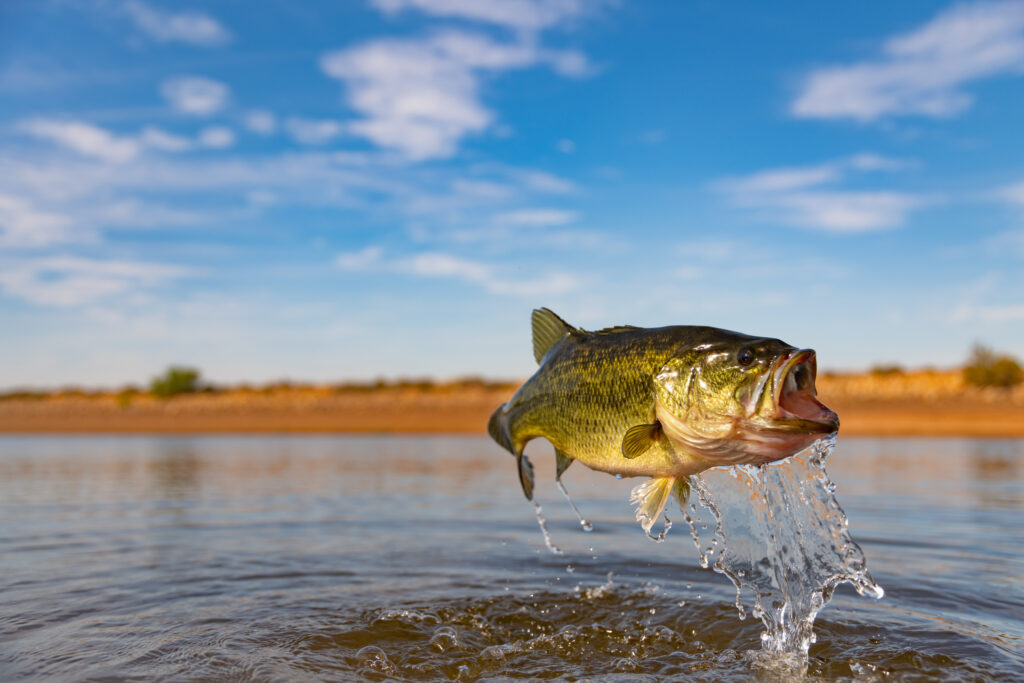
The largemouth bass is the official state freshwater fish of Georgia.
©Ryno Botha/Shutterstock.com
The largemouth bass has a distinctive appearance, characterized by a dark olive-green color on its back and light green sides that fade into a white belly. Along its sides, there is a dark, mottled band. Its mouth extends beyond the eye, making it easy to distinguish from other species, like the smallmouth bass, which has a shorter upper jaw that ends below the eye. Typically, adult largemouth bass are solitary and tend to hide among roots, limbs, or plants to ambush their prey.
The immature largemouth bass is known to congregate in schools, but once they reach adulthood, they tend to remain solitary. Occasionally, a small group of bass may gather in a small area, but they do not interact with one another.
In 1932, Georgia became famous for producing a record-breaking 22 lb 4 oz largemouth bass. This catch is now considered one of the Holy Grails of competitive freshwater fishing and is the reason why largemouth bass is one of the state’s official fish. It is also one of the most popular freshwater fish to eat. Recognizing its significance, the largemouth bass was declared the state fish of Georgia in 1970.
7. Game Bird – Bobwhite Quail (Colinus virginianus)

Georgia named the bobwhite quail as its official state game bird.
©iStock.com/twildlife
The northern bobwhite quail is a visually impressive bird, exhibiting intricate patterns of rufous, brown, black, and buff. The male quails feature a distinct black-and-white head pattern, while females have buffy eyebrows and throats. These quails can grow up to 8 to 10 inches long, with a wingspan between 3 and 5 inches.
Bobwhites are known for their elusive nature, as they tend to keep within the dense low cover and are heard more often than seen. They travel in coveys, which can average about a dozen birds during the fall and winter months.
In the early 1900s, Georgia gained the reputation of being the quail capital of the world, thanks to the abundance of northern bobwhite quail in the state. As a result, in 1970, the bobwhite quail was officially designated as Georgia’s state game bird. However, like many other states, Georgia has witnessed a decline in quail populations, raising concerns among quail hunters and wildlife conservationists.
8. Insect – Honey Bee (Apis mellifera)
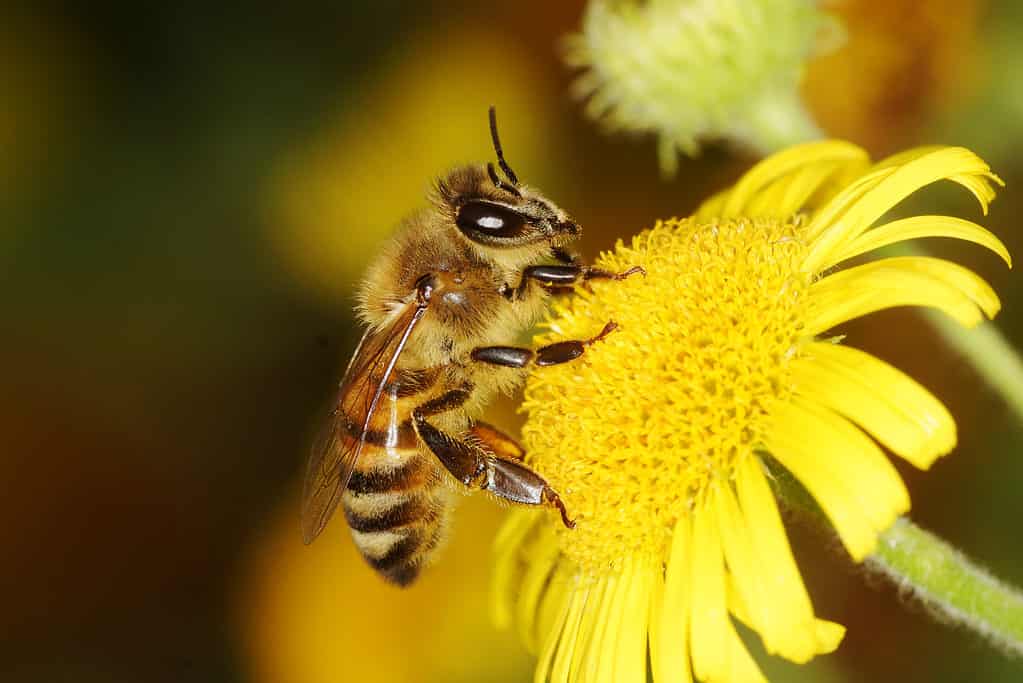
The honey bee is an essential pollinator and one of the official Georgia state animals.
©Maciej Olszewski/Shutterstock.com
The honey bee, known for its unique ability to collect nectar from flowers and produce honey, is a widespread flying insect in various regions worldwide. These bees have stocky bodies with mustard yellow and brown colors and are covered with many hairs to which pollen adheres.
One of the primary values of honey bees is their role as essential pollinators of crops. Their pollination services aid in the growth of numerous plants and contribute significantly to producing various fruits and vegetables.
The worker bees are female honey bees responsible for various tasks necessary for the hive’s functioning and maintenance. In contrast, male bees, known as drones, lack stingers and primarily exist to mate with the queen.
In recognition of its significant contribution to the state’s ecosystem, the honeybee was designated the official state insect of Georgia in 1975. These buzzing creatures contribute significantly to the state’s economy through honey production and are responsible for pollinating over 50 types of Georgia’s crops.
9. Marine Mammal – North Atlantic Right Whale (Eubalaena glacialis)
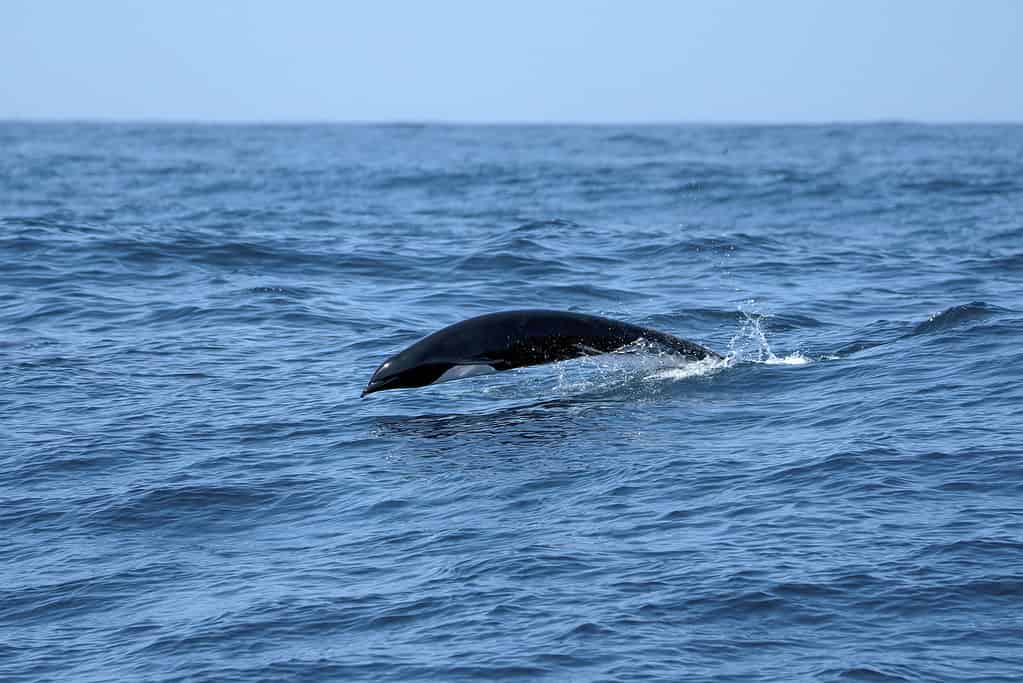
Northern Atlantic right whale are baleen whales and feed by filtering water through their teeth.
©iStock.com/Kara Capaldo
The North Atlantic right whale is a majestic sea creature with a distinctive appearance. Its stout, black body lacks a dorsal fin and is easily recognizable by its V-shaped blow spout. The whale’s tail is all black with a smooth trailing edge and a deep notch, while its belly can be black or have irregular white patches. These whales can reach lengths of up to 52 feet, with newborn calves measuring around 14 feet.
If you’re lucky enough to spot a North Atlantic right whale in the wild, you might witness it breaching out of the water and crashing back down with an enormous splash. Alternatively, you may see the whale swimming with its rostrum above the waterline as it feeds on dense plankton patches.
The waters off the coast of Georgia and North Florida are the only known locations where the species reproduces. As a result, the state of Georgia recognized the importance of the right whale by designating it as the state marine mammal in 1985. This whale was the only state mammal until 2015.
10. Mammal – White-Tailed Deer (Odocoileus virginianus)
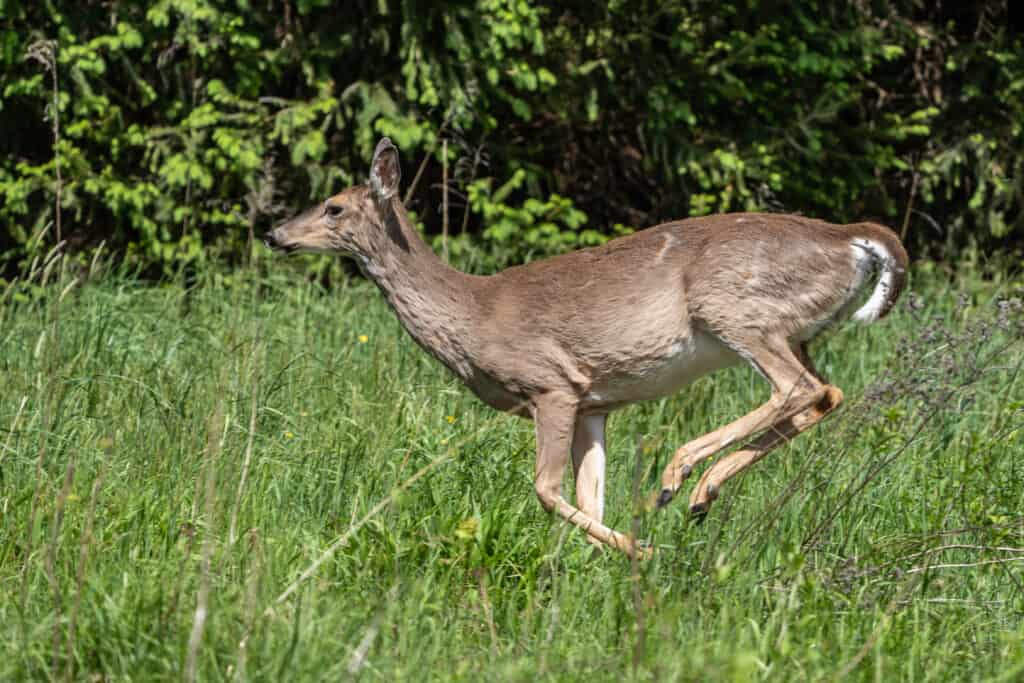
White-tailed deer became an official state mammal for Georgia in 2015.
©Amy Lutz/Shutterstock.com
The white-tailed deer change colors seasonally. It has a tan or brown color in warmer months, but as the weather cools, its fur turns grayish-brown. This deer gets its name from the unique white markings throughout its body. It has a white throat, eye, nose region, belly, and tail. White-tailed deer also have long legs, which help them to reach incredible heights when jumping and running.
These magnificent animals have incredible hearing and sight, which they use to defend and protect themselves from predators. White-tailed deer are usually active during the twilight and disappear at daybreak.
The white-tailed deer only became the official state land mammal in 2015. A group of elementary students worked alongside the Georgia Department of Natural Resources Wildlife Resources Division to recommend an animal for the official state mammal to state legislatures. The group landed on the white-tailed deer, which is abundant throughout the state and has a huge economic impact due to hunting.
11. Reptile – Gopher Tortoise (Gopherus polyphemus)
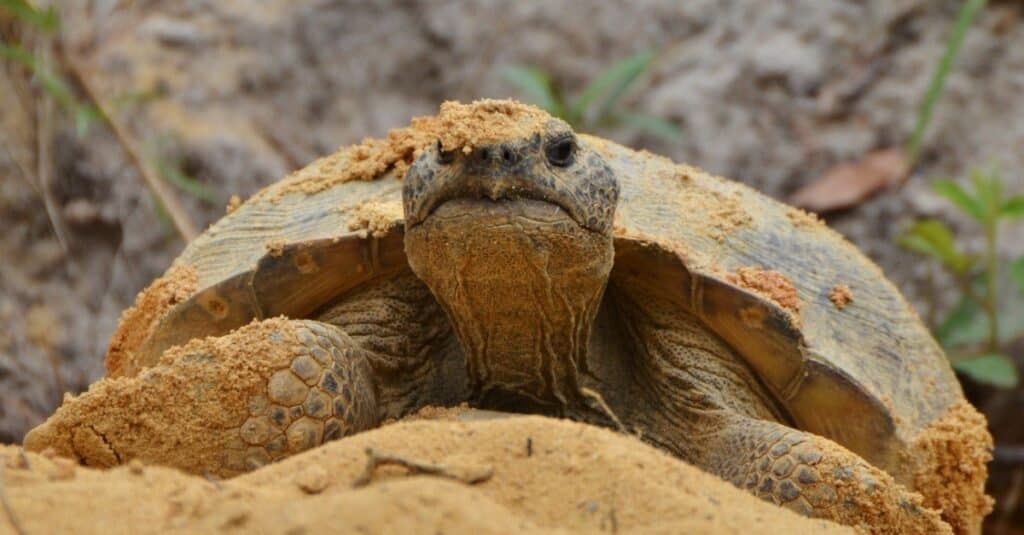
The gopher
tortoise
is endangered and is the official state reptile of Georgia.
©iStock.com/mjf795
This one-of-a-kind land-dwelling turtle can reach up to 15 inches in length but, on average, measures between 9 and 11 inches. With stumpy, elephantine hind feet and flattened, shovel-shaped forelimbs adorned in thick scales, the gopher tortoise has some unique physical attributes that set it apart from other turtles.
True to its name, the gopher tortoise is known for digging deep burrows. Although the tortoise is generally a solitary creature, it may share its burrow with a mate or nest of hatchlings during mating season. Unfortunately, many of these nests are vulnerable to predators like coyotes, raccoons, and eagles that may eat the eggs left unguarded near the burrow’s entrance by the female.
Georgia has designated the gopher tortoise as its state reptile, and the species is listed as threatened under both state and federal law. This recognition and legal protection were put in place in 1989 to help ensure the species’ survival. Currently, efforts are being made to increase the gopher tortoise population by protecting its habitat and promoting conservation programs.
12. Salt Water Fish – Red Drum (Sciaenops ocellatus)
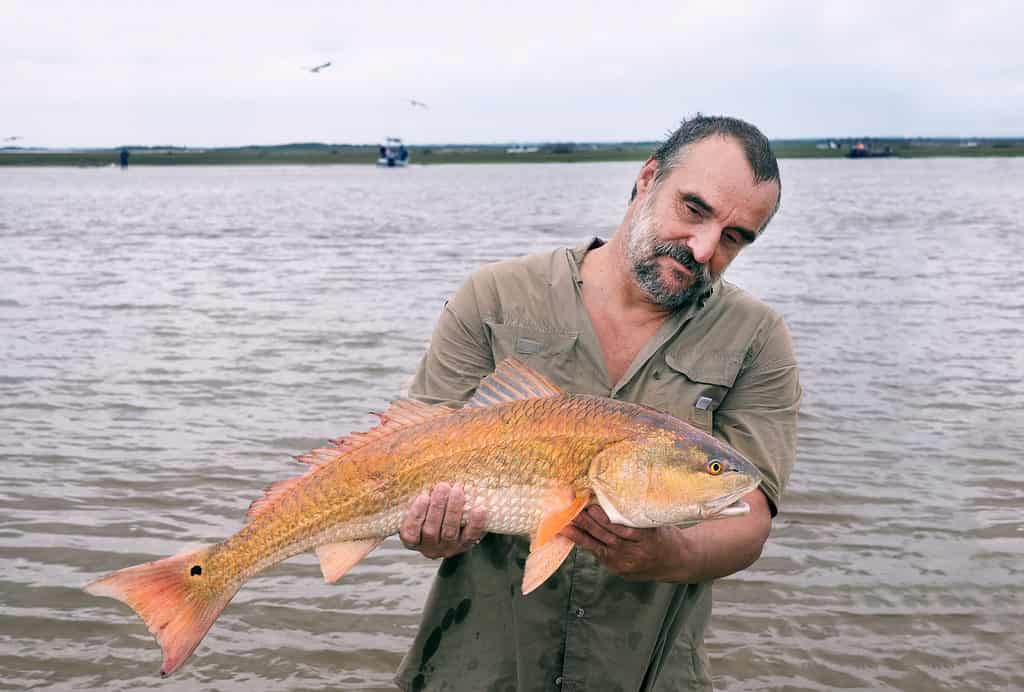
Red drums are popular catches and are Georgia’s official state saltwater fish.
©IrinaK/Shutterstock.com
Red drum, a popular catch among anglers and nature enthusiasts, can grow up to an impressive 30 inches in length and weigh anywhere between 15 and 20 pounds. With their striking iridescent silver-gray color, prominent spot(s) near the tail, and reddish-bronze overtones, it’s no wonder why these fish attract so much attention.
These fascinating creatures prefer shallow, quiet waters with muddy or grassy bottoms, where they feed on decomposing animal and plant matter. During spawning season, male red drums attract females by vibrating a muscle in their swim bladder, producing a drum-like noise.
In 2006, the state of Georgia designated the red drum as the state saltwater fish due to its significant economic, recreational, and ecological importance. Red drum fishing is popular in Georgia’s coastal waters, contributing significantly to the state’s tourism industry and supporting local businesses.
13. Seashell – Knobbed Whelk (Busycon carica)
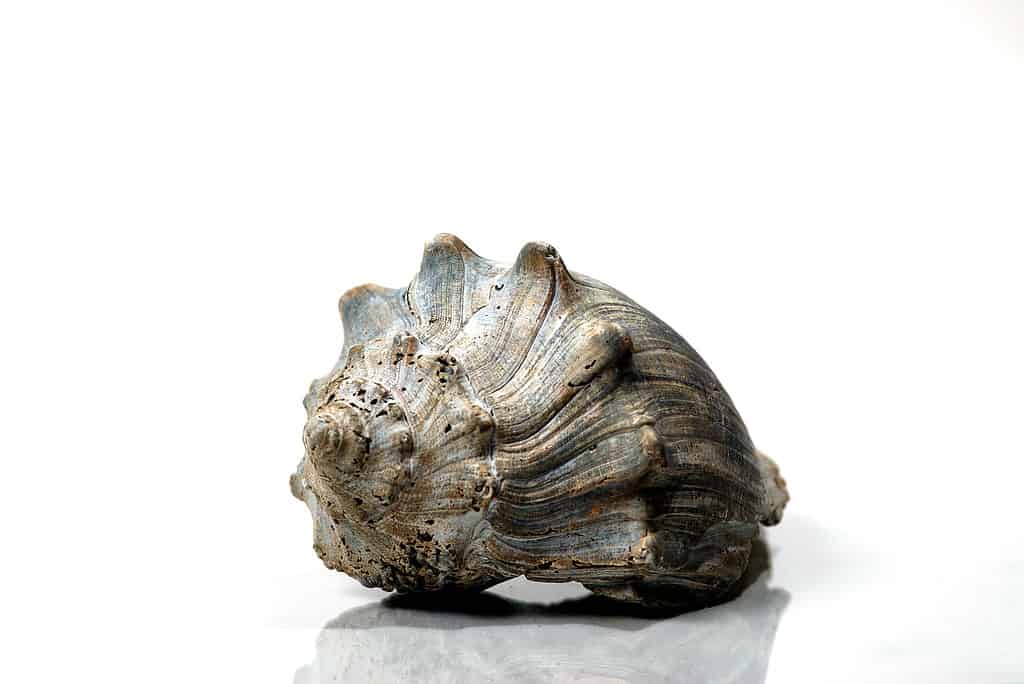
Georgia even has an official seashell, the knobbed whelk.
©iStock.com/ChristopherSZachary
The knobbed whelk is a marine mollusk with a unique and smooth pear-shaped spiral shell adorned with a series of striking triangular bumps on its shoulder; hence the name “knobbed.” Its shell can be found in an array of colors and can range from 5 to 9 inches in length. The opening of the shell, also known as the aperture, can be found on the right side when viewed from above.
This sea creature is migratory and typically resides below the low tide mark, alternating between shallow and deep water depending on the season. During the extreme summer and winter weather, they prefer to live in deeper waters, reaching depths of up to 160 feet. In the more temperate spring and fall temperatures, they can be found in shallower waters, typically inhabiting intertidal mud flats and sand flats.
In recognition of its beauty and significance, Georgia declared the knobbed whelk the official state seashell in 1987. This designation aims to encourage residents and tourists to visit the state’s picturesque beaches and coastal areas.
Summary of the 13 Official State Animals of Georgia
| Type | Animal | |
|---|---|---|
| 1 | Amphibian | Green Tree Frog |
| 2 | Bird | Brown Thrasher |
| 3 | Butterfly | Eastern Tiger Swallowtail |
| 4 | Cold Water Game Fish | Southern Appalachian Brook Trout |
| 5 | Dog | Adoptable Dog |
| 6 | Fish | Largemouth Bass |
| 7 | Game Bird | Bobwhite Quail |
| 8 | Insect | Honey Bee |
| 9 | Marine Mammal | North Atlantic Right Whale |
| 10 | Mammal | White-Tailed Deer |
| 11 | Reptile | Gopher Tortoise |
| 12 | Saltwater Fish | Red Drum |
| 13 | Seashell | Knobbed Whelk |
The photo featured at the top of this post is © Amy Lutz/Shutterstock.com
Thank you for reading! Have some feedback for us? Contact the AZ Animals editorial team.






